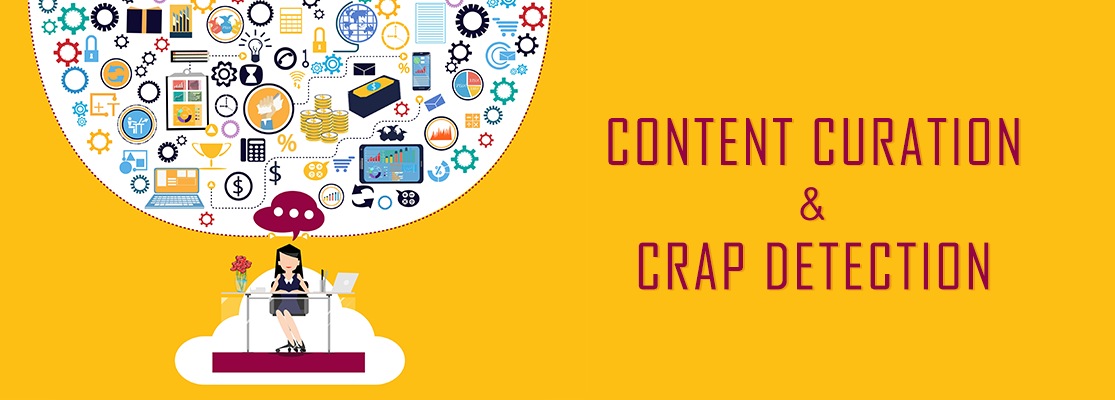CONTENT CURATION AND CRAP DETECTION
Just in case you’re wondering what content curation is all about and why it’s essential, let’s get the definition out of the way first. So here goes…
Content curation is the practice of searching the Internet, sourcing articles relevant to a topic, making sure that they are correct and useful, and sharing them with an audience.
The process is very much like what museum curators and librarians have traditionally done. Today, almost everyone does it, including your friend who tweets inspirational quotes, and the teenager who posts funny cat videos on her Facebook wall. And, the very fact that you’re reading this article shows that you are engaged in some form of content curation, though you may or may not share it with others.
By the same reasoning, our learners do it too. Let’s not, even for a moment, fool ourselves into thinking that our courses, however well designed, will serve as the only source of information for them. Like it or not, they already are searching the internet / intranet, finding the information they need, and sharing what’s useful with their peers.
Having established that curation is an essential part of what we do, the next point is how to do it well. A lot has been written about the process and principles of curation, and I’ll share a few of them at the end of this article. But here, I want to focus on one key aspect that I think can make a huge difference to the quality of what you curate. And that is… filtering. Or as Ernest Hemingway put it, CRAP DETECTION. Someone asked the Nobel prize-winning author if there were one quality needed, above all others, to be a good writer, and he answered “a built-in, shock proof, crap detector.”(*) The year was 1950(**).
Think about this for a moment. The most content a person would have had to go through in 1950 would have comprised of systematically reviewed books and journals. Today, in 2017, everyone is a self-styled writer or publisher, and there are no reviewing mechanisms in place to weed out bad content before it gets out onto the wild web. We have so many rumors, myths, fables, and legends floating around, and it’s our responsibility to separate the accurate, relevant content from the crap. So, the crap detector is now more important than ever.
The first thing that comes to mind when talking about crap detection is sites like Snopes and FactCheck.org, which you use can use to quickly check if something is fact or fiction. But we don’t just deal with factual rumors. We regularly come across ideas, theories, and concepts, and these sites will not help us with these. For instance, type in “learning styles” into the search option in these sites, and they yield no results. So it’s really up to us to use “built-in mechanisms” to detect such misinformation and weed it out ourselves.
A good tool we can use to do this is The Crap Test, which is a series of questions we can ask to determine the veracity of content based on four criteria: Currency, Reliability, Authority and Purpose / Point of View.
I’ve tweaked up the criteria and the questions a bit to suit our purpose. Here they are:
- How recent is the information? (Criteria: Currency)
- Is it current enough for the topic? (Criteria: Currency)
- What kind of information is included in the content? (Criteria: Relevance, Reliability)
- Is the information meaningful / useful for the audience? (Criteria: Relevance)
- Who is the creator or author? What is their expertise on the topic, and what are their credentials? (Criteria: Authority, Reliability)
- Who is the publisher or sponsor? Are they reputable? (Criteria: Authority, Reliability)
- What is the publisher’s interest (if any) in this information? (Criteria: Authority, Reliability)
- Is it primarily data or opinion? If it’s the latter, is it balanced? (Criteria: Purpose / Point of View)
- Does the author provide references or sources for data or quotations? (Criteria: Purpose / Point of View, Reliability)
- Is the creator / author trying to sell you something? (Criteria: Purpose / Point of View, Reliability)
So, any time you’re researching on a topic and come across a new piece of information, ask yourself these questions to find out if the information is actually worth your (and your audience’s) time and attention.
This, I believe, is what primarily differentiates the curator of cat videos from the professional who curates artefacts for the Louvre museum in Paris.
And without this, we will end up suffering from, according to noted author Clay Shirky, “not information overload, but filter failure.”
What mechanisms do you use to filter the good from the bad content out there? Please add your comments at the end of this article. You can also post them on Twitter (@Learnnovators).
FOOTNOTES:
(*) I can’t verify the exactness of the quote. Several sources who have quoted Hemingway use slightly different words, but the meaning remains the same.
(**) The year is not clear either. Sources have put this year down to anywhere between 1950 and 1955.
REFERENCES:
Here are some articles / resources on content curation:
- This brilliant post from Ryan Tracey describes a framework that we can use for curation.
- A great primer on content curation, and why it’s a necessary skillset for learning designers, by David Kelly.
- And another article from Marc Rosenberg.
- A HUGE list of curated resources on curation, again from David Kelly.
Written by Srividya Kumar
(Co-Founder at Learnnovators)
_________________________________
Published on 04-Apr-2017






